Annamayya’s life and lyrical saga

Text Contributed by
Dr. Anupama Kailash
Kuchipudi Exponent
The Sangitaratnakara of Sarngadeva observes that man can achieve all the four objectives (Purusharthas) in life through music, but devout composers of hymns have treated it as a means to attain only religious merit (dharma) and salvation (moksha)
Annamacharya is to be reckoned as the first among the hymno-graphers in Telugu, not only from the view point of chronology but also for his superb artistry and range of feeling and thought. He was a pioneer in the field who could handle both amorous and devotional strains with equal felicity. The eroticism evident in Kshetrayya’s love lyrics and Thyagaraja’s rapturous praises of the glories of Rama are undoubtedly reminiscent of Annamayya’s treatment of these elements in his hymns.
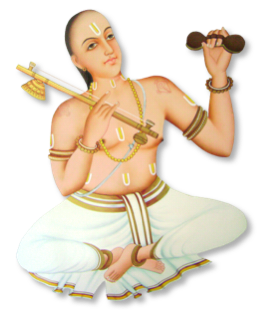
The synthesis of Vishnu of the Rigveda with the cosmic God Narayana of the Brahmana’s ,and then with the popular deity Vasudeva Krishna, in due course ,resulted in the emergence of Vaishnavism. The religion holds Vishnu to be the Supreme God and devotion to him the main objective of human existence. According to Vaishnava theology, descent or incarnation is only one of the five forms through which Vishnu manifests himself. In the ‘Para’ transcendent form, he is Vasudeva, the supreme being, beyond the reach of human experience. The ‘Vyuha’, emanative form is his functional manifestation as a creator, sustainer and destroyer of the Universe. The ‘Vibhava’, incarnate aspect is related to his descent into the world in physical form. In the ‘Antaryamin’, immanent form, he dwells in the hearts of all beings regulating their feelings. And finally in the ‘Archa’, iconic form, he becomes easily accessible to his devotees and receives ritualistic worship from them in temples and homes.
Among the five, the ‘Archa’ is the most sought after form by devotees as it enables them to enjoy the beauty and splendor of the Lord here and now. That is why several saint poets have expressed their wish to be born again and again in the mortal world if only to experience the bliss of beholding Vishnu in their favorite iconic form. The medium favored by all these saint poets to worship their favorite deity was song or ‘Sankeertana’, as it is the most effective medium to reach God in Kaliyuga. It also appeals to the imagination and interest of the common man, amongst whom these saint poets wished to propagate their path of Bhakti or devotion.

Annammayya pioneered singing of Pada or Sankeertana in Telugu language. Annamayya seems to have started composing lyrics at the age sixteen, when he was fascinated by his devotion to Lord Venkateshwara. This devotion is called Madhura Bhakti because it is ‘Godlove’,in which the devotee is the beloved or ‘Preyasi’ or Jeevatma, and the ‘Lord God’ is the supreme hero or Paramatma. Alamelumanga and Venkateshwara represent Radha and Krishna in Vaishnava parlance and they stand for ‘Prakriti and Purusha’ in Sankhya terminology. The same divine pair represent ‘Sakti and Siva’ in Saiva parlance.
After the Saivite Naayanars of 3rd Century and Vaishnavite Alwars between 7th and 12th Century, we have Annamacharya, the earliest composer of lyrics in Telugu in the 15th Century.
Annamacharya was greatly influenced by the legacy of the God intoxicated poet composers, the Alwars. The term Alwar means, “One who is immersed”. In the present context it denotes an ardent devotee ever immersed in God. Twelve such devotees of Vishnu who lived between the sixth and ninth century in the Tamil speaking region of South India are traditionally recognized as the Alwars. The Alwars are held in such high veneration by the Vaishnavas that each of the 108 places they sang about has consequently come to be regarded as a divine place. Annamacharya was well acquainted with the hymns of the Alwars for at least two reasons, one, he was himself a latter-day Alwar, secondly, the foremost exponent of the Vishishtadvaita school of Vaishnivism, Ramanuja, rightly thought that “the real proof of the being of God is the being in God”, and accepted the utterances of the Alwars as authoritative, as the word of God in the Vedas.

As a convert to the Vishishtadvaita sect, Annamacharya had devoted many years to the study of it’s theology. Therefore he shared the emotional mysticism of the Alwars as well as their intense love for the God of the seven hills. Be it Alwars of the 7th to 12th Century, Jayadeva of the 11th Century, Chandidas, Vidyapati or Annamayya, they chose to compose lyrics of God love with predominance of eroticism in their compositions. Their songs had a desi milieu and deserved no reproof from any quarter. Those were the “limits of permissiveness’ as observed by the liberators, painters and architects as part of the Indian ethos of the Middle Ages”.
On one side was the highly evolved Vishishtadvaita concept of a ‘Saguna Parabrahma ‘. Divine love of Gods and their consorts, their union and separation was used as a medium to express exalted Bhakti, and on the other side, the synthesis of Muslim and Hindu thought, gave rise to lyrics extolling the unity of mankind and censure towards caste system.
Literature was written to reach the hearts and minds of the common man and instill values, righteousness and devotion in them. What with devotional fervor at its height, and gradual, political instability, creating the need for spiritual counseling and healing, the scene was just right for the arrival of Annamacharya, whose emotional and devotional fervor, skill and artistry, probably surpasses that of any other poet, before or after him. Writing in lucid Telugu, and with the constant refrain of Bhakti to Lord Venkateshwara and Alamelumanga, Annamacharya was the brightest star in the firmament of poet luminaries.
Annamacharya
The father of Telugu Poetic Literature

Tallapaka Annamacharya, popularly known as ‘Anamayya’, bearing title as the ’Pada Kavitaa Pitamaha’ of telugu poetry was a devoted worshiper who sang thousands of sankeertanas in ode of Sri Tirumala Venkateswara Swamy. He was a reputed singer and an eminent poet who gave life to the Telugu song and lyricism and a saintly emperor of words who blended the Telugu ‘andhra vedam’ to the understanding of common man’s from within the summary of ‘Sanskrit vedas’.
Annamayya was born as the first vocalist of South India to Lakkamamba and Narayana Suri in on 22nd May 1408 B.C. at Tallapaka village, Rajampet Mandal, Cuddapah district. He stands as a legendary singer who sang around 32,000 keeratans in worship of the Lord to find the way to salvation.
In the era, where they were numerous foreign poets reigning over the literature times, Annamayya was the first, who paved way to sing in ode of common man unlike others who only praised the kings and the erudite.
Annamayya is remembered for his saintly life, and is honored as a great devotee of Vishnu by devotees and saintly singers. He was one of the few who amalgamated the folklore and propagated ‘Vaishnavism’ among common people.
He appreciated every phase of life through his songs which include the moon, the temples, birds, flowers, lullabies, praises, austerity, awakenings, tributes and many other folklore activities. He espoused on subjects such as morality, dharma and righteousness and was one of the first few who opposed the social stigma towards the untouchable castes in his era, with his sankeertanas explaining that the relationship between God and human is the same irrespective of the latter’s color, caste and financial status.

Annamayya’s wife Timmakka also is the first poetess in Telugu literature. She composed ‘Subhadra kalyanam’. The sons and grand children of Annamayya were all born poets who continued their writings in the footsteps of Annamayya.
Annamayya words are considered vedic equivalent by their family. Annamayya’s son, Pedda tirumallayya has made all the vedic transcripts into sankeertanas and explained the greatness of Annamayya to everyone. Similarly, Annamayya’s grandson, Chinna tirumallayya has sung about the importance of Annamayya sankeertanas throughout all over the world.

Kadapa district’s name is glorified by the efforts of ‘Tallapaka Poets’. Dhyana Mandiram was constructed in memory of great Saint Annamacharya, at Tallapaka. The Chennakesava swamy temple is located near the Annamacharya temple in Tallapaka. Annmayya died on 4th April 1503B.C. at the age of 94 years at Tirumala.
Annamayya’s Poetic Glory
Diving into Annamayya’s magnificent compositions, a song which every telugu-born mother would sing to her infant at dusk, feeding him morsels of food, by showing the alluring moon is scripted as
“Chandamamaa ravo, jaabilli raavo
Manchi kundanapu vendikora venna paalu taevo”
Later, she cradles the infant by singing a lullaby
“Jo acyutananda jojo mukunda
Rave paramananda rama govinda”
The baby slips into fast sleep by the sweetness of nectar in the songs of Annamayya and the eternal love of the mother. Annamayya’s songs have been entertaining and enchanting the Telugu folks over generations as a blessed boon.

Annamayya preached the philosophy though songs such as “Brahmaṃ Okkatē Paraḥbrahmamokkatē”, “Tandana aahi, Tandana na purae”. He also advocated equality though folk song verse as below.
“Nindara Raju Nidrinchu Nidrayu Nokkate
Andane Bantu Nidra Adiyyu Nokkate
Andariki Sriharae antharaatma”
Which meant, that ‘the king sleeps the same way as the slave sleeps, which proves that the Lord is one for and equal for all.’He also used singing as a medium to convey to the village folks that the ‘Lord Srihari’ is beyond caste and creed which is scripted as
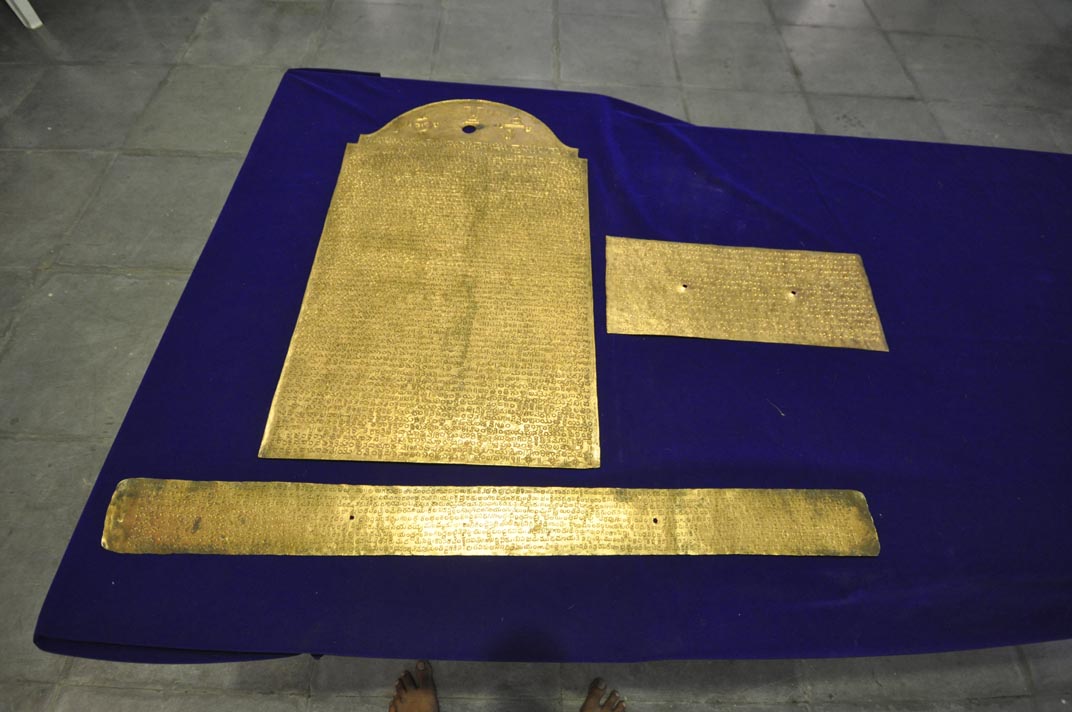
"E kulajudemi evva dainanemi akadanatade harinerigina vadu”
He also spread the message that ‘One who possessed character qualities like truthfulness, justice, and kindness would be the gem among men’. He also scripted many songs the wife of Lords Sri Venkateswara Swami, Goddess ‘Alivelu manga’. One among such is where he extols the eternal beauty of the Goddess. The telugu song has a serene flow of words with charm, tenderness and naturalism.
“Chakkani talliki cangu bhala tana cakkera moviki cangu bhala”

While strolling through villages, we have sights of women pounding the rice on rice-pounders singing ‘Suvvi Suvvi’ hymns of the bustle. As they pound the rice, women make a hissing sound which on sound transition translates into ‘ Suvvi Suvvi’. Annamya sings ‘Suvvi Suvvanu Devaki nandanu ganiyae’ praising the birth of Krishna, where Devaki the mother of Lord Krishna doesn’t experience maternity pains like any other women while Krishna’s birth. Annamayya also enlightens naturalism in the song with the dusk moment, bloom of lotus and the donkey braying.
Sankranthi is one of the prime festivals which signifies the Telugu folk culture. The festive indicates a transition of the winter solstice to summer solstice. We come across many distinctive moments connoting the Telugu folk culture such as ‘ bhogi mantalu, haridasu’s keertanas, bulls dressed and decorated with bells and danced to the tunes of shehnai’s, and the blabbering tunes of ‘pittala doras’,
Young lasses decorate rangoli with flowers, colors and small, hand-pressed piles of cow dung, called “gobbemma” creating a worm-free environment in the house. They join at each house to sing and dance around the rangoli singing ‘Gobbillo, Gobbillo’. Annamayya also scripted on the moment in the below verse

“Kolani dopariki gobbillo, yadukulamu svamikini gobbillo”
Annamayya adroitness is also visible when he sings wit-fully on the quirky relationship between a mother-in-law and a daughter-in-law in similarity with syrupy tussles between Goddess Lakshmi and Goddess Saraswathi in the below verse.
‘Rave kodala rattadi kodala’, says Goddess Lakshmi to Goddess Saraswathi,
‘Pove pove attayya, pondulu nito calunu’, replies Goddess Saraswathi wit-fully.
The whole song goes in the similar humoristic-conversation manner between them. Annamayya also sings about Lord Venkateswara’s lovable moments of joy playing the spring festival with flowers and rose-scented water along with his charming girlfriends
“Jagadapu chanavula jajaraa,
Saginala manchapu jaajaraa”
He also emphasized on the large black carpenter bee in the below verse
“Tollinti vale gavu mam’mu tum’meda!
Inka nolla vuga mam’mu vo tum’meda!
He also blazoned with lyrics on the elements of nature, in which the sun and the moon were compared with Lord Venkateswara’s eyes. With the glory of Telugu language and richness of Telugu words, Annamayya penned the below describing the splendor of the moon
“Sandekada puttinatti cayala panta yenta.
Candamaya cudaram’am candamama panta”
Describing in the tone of folk, Annamayya sings about the moon that it intensifes and cools down a person of any kind as below
‘Arudai turupu konda konda naragabandina panta’
Annamayya also sings about the ‘Dasavataaras-Ten incarnations of Sri Maha Vishnu’ as below
“Arudai thoorupu konda naaragabandina panta”
Annamayya is presented in the folk songs of Sri Dhamma Vishnu. The below song goes as a riddle sung by annamayya.

“Siruta navvula vade sinneka
Polasumenivade ani matsyavataranni
Boravipuvadu ani kurmavataranni
Selasumoravadu ani varahavataranni
Golusula vankala koralato bumi
Velasinadu ani narasimhavatataranni
Meti kuracavadu ani vamanavataranni
Sitakalavadu ani balaramavataranni
Atadai basi adavilo rakasi vetaladi ani ramavatarani
Binkapu motala pillagovi vadu ani krsnavataranni

Hydyanga a varnistadu annamayya”
Annamayya used his folk songs to emphasize on agriculture as well
‘Pottula pampamaneti podu nariki vesi
Cittamaniyedu cenu cenuga dunni
Mattili santamane manic vana padanuna
Vittuduru hari bhakti vivekulu.
Kamakrodhadulane kalupu cesi
Vemaru variragyamane velugu vetti
Domati nacaravidhula yeruvulu vesi

Vomucunnaru jnanapu pairudyaga janulu.”
Annamayya’s below composition emphasized on the traditional weavers and their business style
“Vadala vadala venta vadevo vadevo, nidanundi ciralam’me neta behari”
Ante ceneta pad’dhatulanu, ciralam’me vidhananni teliyajesadu.
On the nomadic folk, who run the puppet show in various places, he sang as below
aatavari guitaura
atavari gudi annichotla bomma
lata ladincha nadhikundavaitivi

gurutaramagu pedda kottamu lopala
tiramaina penu maya tera gatti
araya najnanamu lavi yaddamuga jaesi
paraga sujnana dipamulu muttichi
tolubommala dorakoni gadiyinchi
galiceta vani gadalinchii
tuleti rasamulu tommidi gadiyinchi
nalugu mukhamula naluvuna naadincha
ninnae metturugani nikaemi nilaeru
manninchu datalu mari laeru

yennaga tiruvaenkateswara ni dasu
lunnatulai ninnu nubbin̄ci pogadaga
Annamayya’s singing emphasized and echoed on various folklore lifestyles by singing. For example, “Tirumalayya vindu manchidae undantae untinamma, saravilaeni chenchuvaari sangathaelaa tanaku ani girijanula nirmala bhaktini, neyyamulallo naerellalo, oyyana vooredi vuvillalo”
This song emphasized on the novelty of real happiness.
As a folk lover, the real essence of a sweet lullaby was in this below verse sung by him
‘Laali laali laalemma laali’
Annamayya was evidently an observer of life around him, though he looked at it only in relation to his deity Venkateswara. It would be no exaggeration to say that it is impossible to write about the various social mores, religious festivals, customs, practices and activities that Annamacharya managed to incorporate into his songs. Annamayya was a forerunner of composers such as Purandara Dasa and Tyagaraja.
Annamayya stands remarkable in the Telugu folk history today as a great poet and singer who dedicated all his sankeertanas to Lord Venkateswara and also nourished the folk through his music essence and knowledge.
A special verse of ‘mangala haarathi’ is below, which was found in the research of Annamayya’s compositions signifying as an ode to Annamayya’s contribution and dedication towards the folk music, Telugu language and his devout towards Lord Venkateswara.

Madanuni talliki mangalam – madagaja gamanaku mangalam//pallavi//
kannjadalakshiki kappuragandhiki – manjulaaniki mangalam
manjarikucakunu madhukaraveni(ki) – manjulapadakunu mangalam//1//
induvadanaku(nu) ibharipumadhyaku – mandasmitakunu mangalam
kundaradanakunu gurunitamba kabja – mandira kepuḍu(nu) mangalam//2//
anganamanikini ambujapaniki – mangalavatikini mangalam
ranguga vekataramanu niyalamae – lmangaku neppudu mangalam//3//
Today, they are an integral part of Carnatic concert repertoire even as scholars continue studying and pondering over the lyrics. At times, one can only wonder at the ways of providence and the genius of Annamayya
With growing interest in Annamayya and his life, there are sure to be many more books that will bring him closer to the people than ever before. For someone who had such a powerful influence on the richest temple on planet – but was mysteriously forgotten for many centuries – there is bound to be a fresh wave of enthusiasm in every generation in the foreseeable future.
We ‘The Dance India’ consider this feature as an iota of efforts in portraying the magnanimous life of Annamayya and his musical compositions.
Gallery :

Annamayya_s devoted most of his compositions to Lord Venkateswara 
Sankeerthana bhandaram at Tirumala 
Many musicians perform round the year at Annamayya statue at Visakhapatnam 
Annamayya sings along in glory 
Annamayya_s inscriptions 
Tallapaka Village entrance 
Annamayya_s music and composition devotes all to Lord Venkateswara

Annamayya singing in praise of Lord Venkateswara 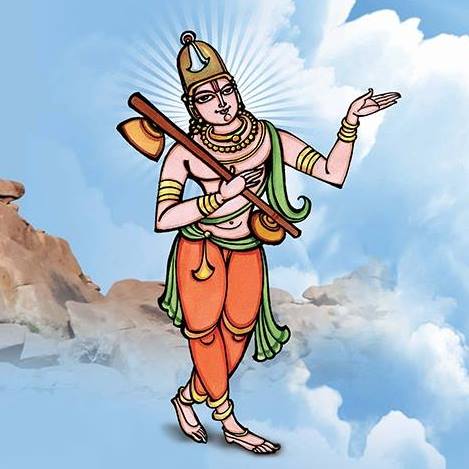
Annamayya sings along in glory 
Annamayya statue at Tank Bund,Telangana 
Annamayya 
Annamayya 
Bapu_s art of Annamayya 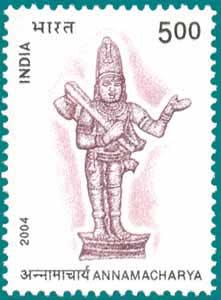
Postal Stamp released on Sri Annamacharya in the year 2004 
Sri Annamacharya with Lord Venkateswara 
Tallapaka Venkata Nagabushan , the 12th generation decendent of saint poet Annamasyya still sings songs at the Tirumala Temple 
Annamayya 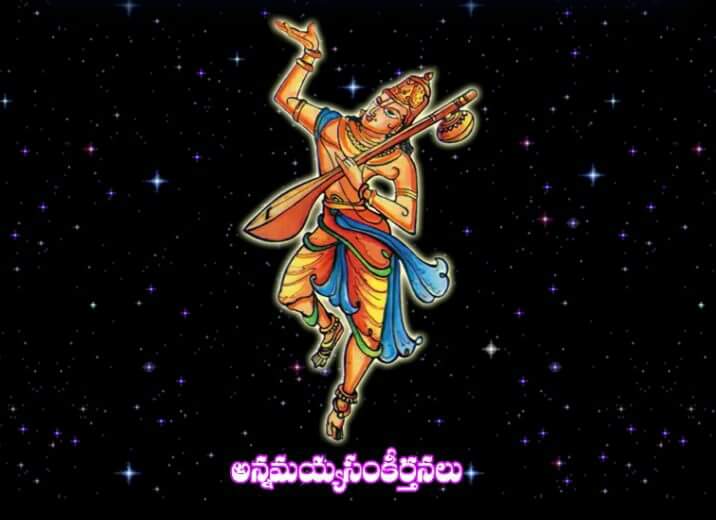
Annamayya




